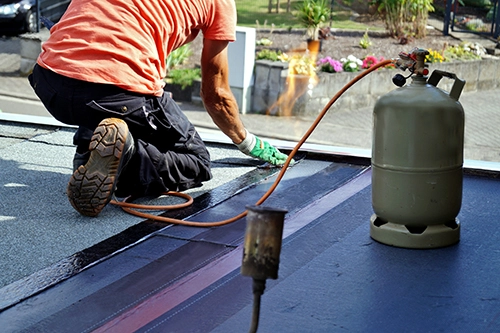- About Us
- Services
- Blog
- Contact
Need a quote?
When your roof needs urgent attention, it’s easy to panic and hire the first contractor you find. Or, even worse, to hire someone who turns up on your doorstep and tells you there’s a problem with your roof!
Unfortunately, this is exactly what rogue roofers rely on. Roofing scams are more common than many homeowners realise, especially in cities like London, where older buildings and unpredictable weather create frequent roofing issues.
To help you avoid getting caught out, here are some common red flags to look out for when hiring a roofing contractor.




One of the biggest red flags is when a roofer knocks on your doorstep uninvited, claiming that they’ve noticed ‘damage to your roof’ whilst working nearby. Reputable companies don’t operate this way. Always be cautious of tradespeople who turn up on your doorstep uninvited.
If a roofer is pushing you to make a decision on the spot, especially if they claim there’s a ‘limited time offer’ or ‘today only deal’, walk away. Quality roofers will always give you time to consider the quote and to do your own research.
Be wary of roofers who insist on cash-only payments or large amounts of money up front. Whilst a deposit might be reasonable, you should never have to pay in full before the work starts.
Every professional roofing company should be able to provide:
If they can’t or won’t provide any of these things when asked, this should be a big red flag.
Whilst we’re not saying every roofer should have thousands of followers on socials, absolutely no online presence is suspicious. In today’s world, most legitimate companies will have at least a basic website, Google profile, or some social media presence.
If you can’t find any trace of a business online, there’s probably a good chance they’re not genuine.
Everyone loves a good deal, but you know the old saying, ‘If it sounds too good to be true, it probably is’. Be wary of quotes that are significantly lower than others you’ve received. Scammers will usually undercut the competition, then do the bare minimum (or nothing at all) before doing a disappearing act.
At Environ Roofing, we believe in clear communication, transparent pricing, and work that speaks for itself. Whether you're dealing with a minor repair or a full roof replacement, you can trust us to get it done right, no pressure, no surprises.
It depends on the construction, but the minimum weight a flat roof must be capable of bearing is 300lbs. This refers to a concentrated weight where a load is positioned on just one area of the roof. So, for example, a commercial flat roof can approximately support a 300lb HVAC unit in a 2.5×2.5ft single space.
If you opt for a flat roof anywhere on your property, remember that it comes with a need for proper maintenance. Low-slope roofing London-wide should be checked every six months or so, or after spells of bad weather, to spot any signs of damage. No matter how small, these should be addressed before they escalate. Remove any debris (leaves, twigs and so on) regularly to avoid these blocking the gutters and allowing water to pool and stand on the roof.
If there are trees in the close vicinity, keep them cut back to reduce the amount of foliage that falls on your flat roof. And check internally for signs of moisture, dampness or water damage on a regular basis. Spotting problems early means resolving them will be cheaper in the long run.

Building a flat roof can be done in three ways. The simplest and most cost-effective choice for levelled roofing London-wide is to construct a warm roof where a roofing membrane is placed over the insulation that keeps the timber structure warm. Another option is to create a cold roof where insulation is positioned between the rafters under the ply roof covering. This is commonly applied to flat-roofed extensions.
The third method is the hybrid roof that contains diverse elements. Their designs require a gap of ventilation above a warm roof to prevent excess moisture within the roof structure.
If you’re looking for flat roofing local contractors, don’t just select the first firm you come across. Find a roofing company that’s been in business for a while and can demonstrate a good track record in installing, repairing, and replacing flat roofs specifically. Ask for recommendations from your own network or from a local trade association. If you need refurbishment work done to 50% or more of your roof, you’ll need a roofing contractor who can self-certify their work under the Competent Person Scheme. Otherwise, the Building Control department at your local authority will need to approve the job before it begins.
Ask whether they are covered by liability insurance and how long they’ll guarantee the work they will carry out. And never just opt for the cheapest quote unless you’re quite sure they’re the best company for the job. You can’t afford to compromise on your roof as the structural integrity of your property depends on it.
Ensuring your flat roof will comply with building regulations before installation can save property owners time, money and stress. First, the roof must have a slope of around 1:80, with water draining away to one or two roof edges. Waterproofing must be extended up to the adjacent walls with at least 150 mm from the surface of the roof.
Contractors must install ventilation in cold roofs. For warm roofs, the deck must be bonded with a VCL. The roof should have the capacity to withstand strong winds and be sturdy enough to take an individual’s weight. Finally, check whether planning permission is needed. Typically, this is only required if you live in a conservation area or a listed building, or are making significant changes to an existing roof.
If you’re looking for top roofing solutions at competitive rates, check out our range of roofing services at Environ Roofing Company London. To get started, call one of our representatives today!

